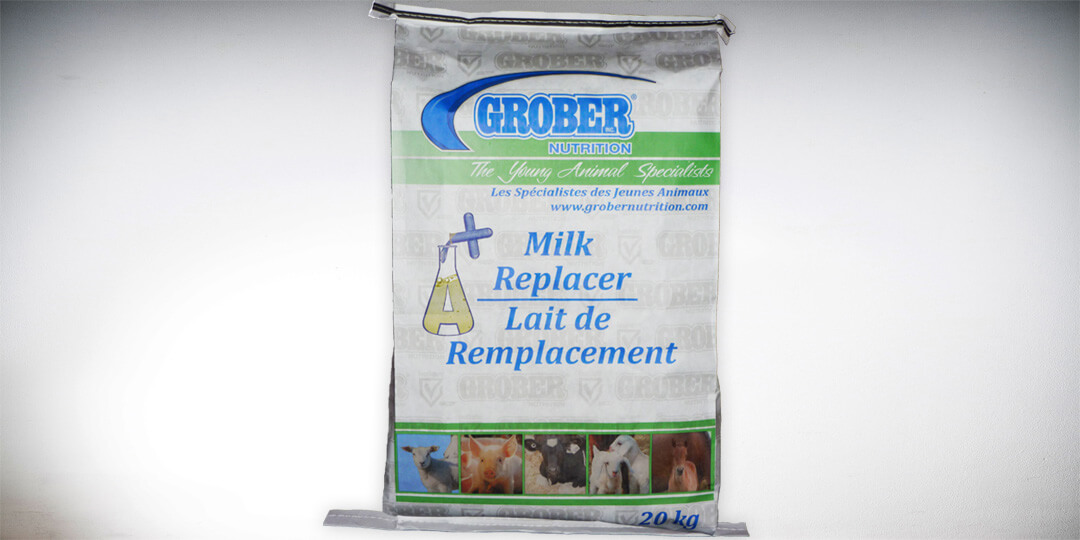Lamb Gro A+ – An Effective Management Tool
- Dec 02, 2013
- By Grober Nutrition
- In Canada, USA
 Management strategy defines the success of lamb rearing programs. Lambs are challenged from birth with an immature immune system, and at the same time they are born with little energy reserves and programmed to grow quickly. Delivering a high quality, clean, and proper quantity of colostrum 1-2 hours of birth sets the stage for health right from the start. A large part of managing young lambs is their milk feeding program. It is an important first step to ensure that the milk replacer has been formulated with good-quality ingredients and nutritional components for optimal digestion and growth. Grober Nutrition conducts research to support the nutrition of young animals, finding new management strategies to improve health and growth. One study, conducted in 2009 at the Grober Young Animal Development Centre, examined how providing small multiple meals daily, through individual feeding, mob feeders, and an automatic Lamb Eco Feeder enable young lambs to exhibit their natural feeding behavior. This trial, along with external research from Donald C. Sockett, DVM in Winsconsin, has shown how providing multiple feedings to young ruminants accelerates their growth, improves health, reduces refusals, and enriches their overall well-being (DHCA, 2013). Animal agriculture has traditionally relied on medication in the feed to help maintain animal health. As regulations change and consumer pressures increase, a reduction in usage of medication becomes the landscape of the future. However, the fact remains that young animals will be exposed to pathogens and producers need another tool in the toolbox to fight on-farm disease pressure. Acidification of milk replacer is a concept that has been studied and used for many years. Acidification refers to lowering the pH of the milk with the addition of organic acids. Often two different types of programs are discussed simultaneously.
Management strategy defines the success of lamb rearing programs. Lambs are challenged from birth with an immature immune system, and at the same time they are born with little energy reserves and programmed to grow quickly. Delivering a high quality, clean, and proper quantity of colostrum 1-2 hours of birth sets the stage for health right from the start. A large part of managing young lambs is their milk feeding program. It is an important first step to ensure that the milk replacer has been formulated with good-quality ingredients and nutritional components for optimal digestion and growth. Grober Nutrition conducts research to support the nutrition of young animals, finding new management strategies to improve health and growth. One study, conducted in 2009 at the Grober Young Animal Development Centre, examined how providing small multiple meals daily, through individual feeding, mob feeders, and an automatic Lamb Eco Feeder enable young lambs to exhibit their natural feeding behavior. This trial, along with external research from Donald C. Sockett, DVM in Winsconsin, has shown how providing multiple feedings to young ruminants accelerates their growth, improves health, reduces refusals, and enriches their overall well-being (DHCA, 2013). Animal agriculture has traditionally relied on medication in the feed to help maintain animal health. As regulations change and consumer pressures increase, a reduction in usage of medication becomes the landscape of the future. However, the fact remains that young animals will be exposed to pathogens and producers need another tool in the toolbox to fight on-farm disease pressure. Acidification of milk replacer is a concept that has been studied and used for many years. Acidification refers to lowering the pH of the milk with the addition of organic acids. Often two different types of programs are discussed simultaneously.
• Program 1– On-farm Acidification: Formic acid is added to the milk replacer when it is being mixed on-farm, best added when the milk is cool (with careful attention that you aren’t adding more liquid and reducing the percent of solids fed) since it can cause clotting if skim milk powder is a part of the formulation. This type of acidification program supports ad-libitum milk programs – lowering the pH to 4.2-4.5 which may retard bacterial growth, allowing milk to be left available for lambs at all times.
• Program 2: Lamb Gro A+: Organic acids are embedded in the formulation of the milk replacer. The formulation achieves a two-fold purpose. One, the acid helps to lower the pH of the solution once mixed (approx. pH of 5.5) and secondly, one of the acids dissociates in the milk replacer during digestion. This program has been associated with less scouring, increased intakes and lower pH in the abomasum (true stomach). The reduction of pH in the abomasum is expected to improve digestion of milk ingredients by facilitating clot formation and maintaining a more stable pH in the stomach post-meal. To evaluate acidification of milk replacer as an alternative to medication, Grober conducted a study at a commercial heifer-raising facility. 268 heifer calves were admitted into the study over a period of six months. Calves were allocated to one of four milk replacer groups: acidified – medicated; acidified – not medicated; regular milk replacer – medicated; regular milk replacer – not medicated. Table 1 reflects an estimated cost per pound of gain based on the average feed:gain ratio for each group. Based on the results, using acidified milk replacer had a beneficial effect on milk intake, reduction in health events and proves to be an effective management tool.
|
Milk replacer group |
# of animals |
Health events |
Average daily gain (lbs/day) |
Total milk replacer intake over 8 weeks (lbs) |
Cost of gain ($/lb)* |
| Acidified-medicated |
79 |
3 ± 1a |
2.5a |
135a |
1.33 |
| Acidified |
77 |
2 ± 1b |
2.5a |
128b |
1.31 |
| Regular – medicated |
73 |
2 ± 1b |
2.4a |
128b |
1.31 |
| Regular |
39 |
3 ± 1a |
2.0b |
122c |
1.43 |
Table 1 Trial results for 268 Holstein heifer calves fed milk replacer with and without acidification. In deciding whether acidified milk replacer will fit into your operation, evaluate your lambs’ environment and the opportunities you have available. Whether feeding Lamb Gro or Lamb Gro A+, it is important to follow best management practices for cleanliness and feeding. Bacteria populations will double every twenty minutes-thus it is important to clean mixing and feeding utensils as often as possible. The most effective way to wash utensils is with an initial rinse, followed by a hot water-detergent soak, and rinsing with hot water. With any milk replacer, it is best to prepare fresh batches at least twice daily. Extra portions can be stored in the refrigerator for up to 24 hours. Before serving, re-heat the milk replacer by using a warm water bath or warming in a microwave at the medium setting. Once the milk replacer is warmed, re-mix into solution, and use a thermometer to ensure a correct feeding temperature. If you are looking to provide the benefits of small multiple meals with more labor convenience, An Eco Feeder becomes a great option, as it combines convenience for you with the security of knowing your lambs are being fed often and consistently. Whichever system you have on your operation, Lamb Gro A+ is another management tool to help raise young stock successfully for a healthy, sustainable flock…RIGHT FROM THE START.
Grober Nutrition
Recent Posts
Tags
Archives
- October 2024
- July 2024
- May 2024
- April 2024
- January 2024
- December 2023
- October 2023
- September 2023
- August 2023
- June 2023
- December 2022
- November 2022
- October 2022
- August 2022
- July 2022
- June 2022
- May 2022
- April 2022
- March 2022
- February 2022
- January 2022
- August 2021
- February 2021
- September 2020
- June 2020
- April 2020
- May 2017
- April 2017
- October 2016
- September 2016
- August 2016
- March 2016
- March 2015
- January 2015
- December 2014
- December 2013
- September 2013
- May 2013
- January 2013
- December 2012
- November 2012
- March 2012
- March 2011
- February 2011
- November 2010
- August 2010
- December 2009
- November 2009
- March 2009















